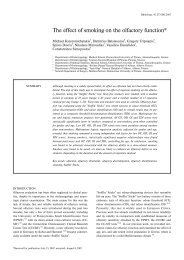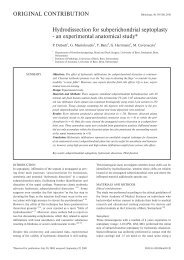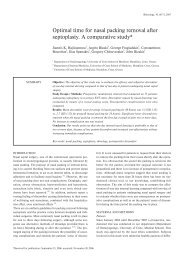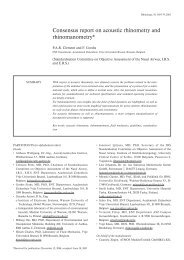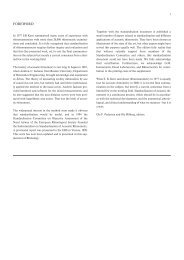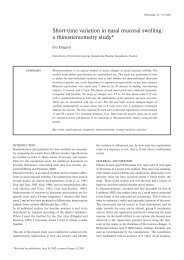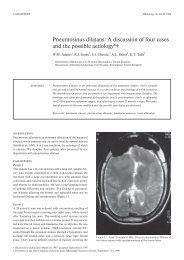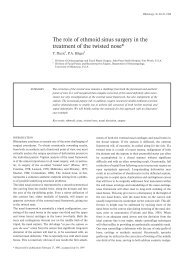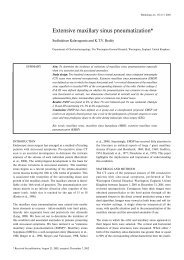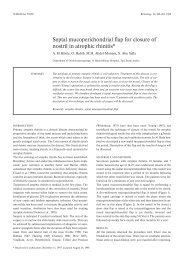IL-4 And TNF - Rhinology Internation Journal
IL-4 And TNF - Rhinology Internation Journal
IL-4 And TNF - Rhinology Internation Journal
You also want an ePaper? Increase the reach of your titles
YUMPU automatically turns print PDFs into web optimized ePapers that Google loves.
<strong>Rhinology</strong>, 45, 235-241, 2007<br />
<strong>IL</strong>-4 and <strong>TNF</strong>-α increased the secretion of<br />
eotaxin from cultured fibroblasts of nasal polyps<br />
with eosinophil infiltration*<br />
Kousuke Yoshifuku, Shoji Matsune, Junichiro Ohori, Yukari Sagara,<br />
Tatsuya Fukuiwa, Yuichi Kurono<br />
Department of Otolaryngology Head and Neck Surgery, Kagoshima University Graduate School of Medical<br />
and Dental Sciences, Kagoshima, Japan<br />
SUMMARY<br />
Background: Nasal polyposis is considered a subgroup of chronic rhinosinusitis (CRS).<br />
Eosinophils are the most common inflammatory cells in nasal polyp and the degree of the tissue<br />
eosinophilia is correlated with the probability of the recurrence of nasal polyps. However,<br />
the mechanism by which eosinophils are selectively recruited in nasal polyp remains to be clarified.<br />
In the present study, fibroblasts were isolated from nasal polyps of patients with<br />
eosinophil-rich nasal polyps (Enp) and those with non-eosinophilic nasal polyps (NEnp) and<br />
the secreted levels of eotaxin, regulated upon activation normal T expressed and presumably<br />
secreted (RANTES), and vascular cell adhesion molecule-1 (VCAM-1) from the cultured<br />
fibroblasts were determined. The levels were compared between Enp and Nenp. The role of<br />
those chemokines and adhesion molecules in the pathogenesis of nasal polyp is discussed.<br />
Methods: Fibroblasts isolated from nasal polyps of five patients with CRS with Enp and four<br />
patients with CRS with NEnp were cultured and stimulated with 10 ng/ml of tumor necrosis<br />
factor-α (<strong>TNF</strong>-α) and interleukin-4 (<strong>IL</strong>-4) for 24 hours. After stimulation, culture supernatants<br />
were collected and concentrations of eotaxin, RANTES, and VCAM-1 were quantified by<br />
Enzyme linked immunosorbent assay (ELISA).<br />
Results: <strong>TNF</strong>-α enhanced the secretion of VCAM-1 and RANTES by fibroblasts derived from<br />
both NEnp and Enp, but did not affect the release of eotaxin. <strong>IL</strong>-4 increased the secretion of<br />
VCAM-1 and eotaxin but not that of RANTES. Furthermore, <strong>TNF</strong>-α and <strong>IL</strong>-4, when added<br />
together, induced a synergistic effect on the secretion of VCAM-1 and eotaxin. The effect of <strong>IL</strong>-<br />
4 and <strong>IL</strong>-4 plus <strong>TNF</strong>-α on eotaxin release was more marked for Enp fibroblasts compared with<br />
NEnp fibroblasts.<br />
Conclusions: The results suggest that eotaxin plays an important role in the selective recruitment<br />
of eosinophils in Enp. Nasal fibroblasts in Enp are more sensitive than those in NEnp<br />
regarding eotaxin release induced by the stimulation with <strong>IL</strong>-4 and co-stimulation with <strong>TNF</strong>-α<br />
and <strong>IL</strong>-4. This difference might be associated with the pathogenesis of nasal polyposis having<br />
marked accumulation of eosinophils.<br />
Key words: eosinophil, eotaxin, fibroblast, nasal polyp<br />
INTRODUCTION<br />
Nasal polyposis is considered a subgroup of chronic rhinosinusitis<br />
(CRS) and eosinophils are the most common inflammatory<br />
cells in nasal polyps (1) . Nasal polyposis with marked<br />
accumulation of activated eosinophils is quite intractable and<br />
often complicated by non-atopic asthma and aspirin-induced<br />
asthma (AIA) (2) . Recently, Dhong et al. (3) compared the sinus<br />
mucosal histopathologies of CRS between asthmatic patients<br />
and non-asthmatic patients. They found that eosinophil infiltrations<br />
were more prominent in asthmatic patients compared<br />
to non-asthmatic patients. CRS in asthmatic patients showed<br />
worse outcomes than in nonasthmatic patients after endoscopic<br />
sinus surgery (4) , indicating that eosinophil infiltration into<br />
nasal polyps and sinus mucosa is associated with the presence<br />
of asthma and the intractable pathology of CRS. Moreover,<br />
oral steroid effectively reduces eosinophilia and shrinks nasal<br />
polyps (5) . Surgical resection of nasal polyps reduces both<br />
eosinophilia and urinary concentration of cysteinyl<br />
leukotrienes in patients with AIA (6) . These findings suggest<br />
that eosinophilic accumulation in nasal polyps is not only a<br />
*Received for publication: September 21, 2006; accepted: February 8, 2007
236 Yoshifuku et al.<br />
consequence but also a cause of systemic events in non-atopic<br />
asthma. However, the mechanism by which eosinophils are<br />
selectively accumulated in nasal polyps remains unclear.<br />
It has been widely acknowledged that chemokines, such as<br />
eotaxin and regulated upon activation normal T expressed and<br />
presumably secreted (RANTES), and adhesion molecules,<br />
such as vascular cell adhesion molecule-1 (VCAM-1), are<br />
important in selectively recruiting eosinophils into the respiratory<br />
mucosa (7-9) . These factors are produced from epithelial<br />
cells, fibroblasts, and inflammatory cells and this production is<br />
up-regulated by stimulation from several inflammatory factors.<br />
In our previous study, VCAM-1 production from fibroblasts isolated<br />
from nasal polyps was enhanced by the stimulation with<br />
<strong>TNF</strong>-α (10) . Nasal fibroblasts also produce eotaxin and RANTES<br />
in response to <strong>TNF</strong>-α, <strong>IL</strong>-4, <strong>IL</strong>-13, and endotoxin (11-15) .These<br />
findings suggest that fibroblasts play an important role in the<br />
recruitment of eosinophils in nasal polyps.<br />
Furthermore, it can be speculated that the production of<br />
eosinophil-specific chemokines and adhesion molecules from<br />
nasal fibroblasts is higher in eosinophil-rich nasal polyp (Enp)<br />
than non-eosinophilic nasal polyp (NEnp), and which might be<br />
associated with the selective recruitment of eosinophils in Enp.<br />
However, the released levels of eosinophil-specific chemokines<br />
and adhesion molecules from nasal fibroblasts and the differences<br />
between Enp and NEnp have not been investigated.<br />
In the present study, nasal fibroblasts were isolated from Enp<br />
and NEnp and the released levels of eotaxin, RANTES, and<br />
VCAM-1 from those fibroblasts were determined. By comparing<br />
the released levels of these chemokines and adhesion molecules,<br />
their role in the pathogenesis of nasal polyposis is discussed.<br />
MATERIALS AND METHODS<br />
Classification of Enp and NEnp<br />
Tissue from nasal polyps obtained by surgery from twelve<br />
patients with CRS was fixed in formalin and stained with<br />
hematoxylin and eosin, and the number of eosinophils was<br />
counted at x 200 magnification under light-microscopy. Five<br />
fields were examined for each section and the average was<br />
considered the number of eosinophils infiltrating the sample<br />
(16,17) . Among twelve nasal polyps, five samples having more<br />
than 100 eosinophils and four samples having 10 or fewer<br />
eosinophils were extracted and tentatively classified as Enp<br />
and NEnp, respectively. Three samples having eosinophils<br />
between 10 and 100 were excluded from the examination. The<br />
study was approved by the Institutional Review Board of<br />
Kagoshima University Hospital.<br />
Clinical background of patients<br />
The background of the nine patients involved in this study is<br />
shown in Table 1. In the NEnp group, all patients were male,<br />
while in the Enp group, three were male and two were female.<br />
Table1. Clinical background of patients enrolled in the study.<br />
Nenp<br />
Enp<br />
No. of patients 4 5<br />
Male 4 3<br />
( Female 0 2 )<br />
Age (y.o) 15-72 48-61<br />
(mean 40.1 52.2)<br />
Nasal allergy 0% (0/4) 0% (0/5)<br />
Asthma 0% (0/4) 60% (3/5)<br />
Eosinophils (No/foeld) 0-10 116-556<br />
(Mean 3.0 349.2)<br />
The NEnp and Enp groups did not differ significantly in mean<br />
age. Nasal allergy was not found in any subject. Asthma was a<br />
concomitant disease in three of five patients with Enp. Any<br />
medicines such as leukotriene antagonist, anti-histamine, and<br />
antibiotics had not been administered to the patients at least 2<br />
weeks prior to surgery. None of the subjects had taken oral,<br />
nasal, or inhaled steroids for more than a year before the<br />
surgery.<br />
Reagents<br />
Human recombinant <strong>TNF</strong>-α and <strong>IL</strong>-4 were both purchased<br />
from CHEMICON <strong>Internation</strong>al Inc. (Temecula, CA, USA).<br />
Preparation of nasal fibroblasts<br />
Nasal fibroblasts were isolated and cultured from Enp and<br />
NEnp as described previously (18) . In brief, nasal polyps were<br />
cut into small fragments and agitated in RPMI-1640 medium<br />
containing a mixture of 10 UI/ml DNAse, 500 UI/ml collagenase<br />
type IV, and 30 UI/ml hyaluronidase (all enzymes were<br />
purchased from Sigma, St Louis, MO) on a magnetic stirrer for<br />
2 h at 37°C. The cells were then cultured at 37°C in 5% CO 2<br />
until they reached confluence in Dulbecco’s Modified Eagle’s<br />
Medium (DMEM; Invitrogen Corp., Carlsbad, CA, USA) supplemented<br />
with 10% fetal bovine serum (FBS). Fibroblasts<br />
were identified by phase-contrast microscopy and absence of<br />
contamination with epithelial cells and leukocytes was confirmed.<br />
The cells were then characterized by flow cytometry<br />
using an anti-human Thy-1 antibody (Dianova, Hamburg,<br />
Germany) in order to examine the purity; fibroblast purity was<br />
more than 99%. The cells were used throughout the study after<br />
two passages.<br />
ELISA<br />
After reaching confluence, the medium was removed and the<br />
fibroblasts were exposed to serum-free medium with human<br />
recombinant <strong>TNF</strong>-α and <strong>IL</strong>-4. The negative control consisted<br />
of cells cultured without stimulation. The cultured supernatants<br />
were collected and the concentrations of eotaxin,<br />
RANTES, and VCAM-1 in the culture supernatants were measured<br />
with sandwich ELISA kits (R&D Systems, Minneapolis,<br />
MN, USA) according to the manufacturer’s instructions.
Eotaxin expression in nasal polyps 237<br />
RT-PCR<br />
After stimulation with <strong>TNF</strong>-α or <strong>IL</strong>-4, total mRNA was isolated<br />
from cultured fibroblasts for RT-PCR using a High Pure<br />
RNA Isolation kit (Roche, Mannheim, Germany) and reversetranscribed<br />
using 1st Strand cDNA Synthesis kit (Roche). Real<br />
time PCR was then performed with Light Cycler Fast Start<br />
DNA Master SYBR Green (Roche) using specific primer sets<br />
for <strong>IL</strong>-4 receptor (<strong>IL</strong>-4R) and ‚-actin as the internal control. The<br />
primer combinations were: 5’-CATAGCACAACAGGCA-<br />
GACG-3’ and 5’-GACCTGGAGCAACCCGTATC-3’ for <strong>IL</strong>-<br />
4R (predicted 335-bp fragment) (19) and 5’GTGGGGCGCC-<br />
CCAGGCACCA3’ and 5’CTCCTTAATGTCACGCAC-<br />
GATTTC-3’ for β-actin (predicted 540-bp fragment).<br />
Statistical analysis<br />
The concentrations of eotaxin, RANTES and VCAM-1 measured<br />
by ELISA are expressed as means ± standard error (SE).<br />
Data were statistically analyzed using two-way analysis of variance<br />
(ANOVA). Values of p < 0.05 were considered significant.<br />
RESULTS<br />
Time-dependent eotaxin secretion from fibroblasts in response to<br />
<strong>TNF</strong>-α and <strong>IL</strong>-4<br />
In order to determine the optimum culture time for nasal<br />
fibroblasts to produce eotaxin, fibroblasts isolated from NEnp<br />
were stimulated with either 10 ng/ml of <strong>TNF</strong>-α or <strong>IL</strong>-4 and the<br />
concentrations of eotaxin in culture supernatants were examined<br />
at 12, 24, and 48 hours after incubation. The secretion of<br />
eotaxin increased in a time-dependent manner until 24 hours<br />
in the cells stimulated with <strong>TNF</strong>-α or <strong>IL</strong>-4 and in unstimulated<br />
control cells (Figure 1). Stimulation with <strong>IL</strong>-4 significantly<br />
increased eotaxin secretion compared to the control, while that<br />
eotaxin(pg/ml)<br />
10 5<br />
-4;10 (ng/ml)<br />
with <strong>TNF</strong>-α did not. In all groups, eotaxin secretion was not<br />
enhanced by 48 hours incubation compared to 24 hours incubation.<br />
Based on the results, cells were cultured for 24 hours in<br />
all experiments. Furthermore, a previous study (11) and preliminary<br />
experiments showed that the secretion of VCAM-1 and<br />
RANTES from nasal fibroblasts plateaued at 24 hours after the<br />
incubation with 10 ng/ml of <strong>TNF</strong>-α or <strong>IL</strong>-4 (data not shown).<br />
Dose-dependent eotaxin secretion from fibroblasts in response to<br />
<strong>IL</strong>-4 and <strong>TNF</strong>-α<br />
The optimum doses of <strong>TNF</strong>-α and <strong>IL</strong>-4 to stimulate nasal<br />
fibroblasts were determined by the application of various concentrations<br />
of <strong>TNF</strong>-α and <strong>IL</strong>-4 to cultured fibroblasts derived<br />
from NEnp for 24 hours. The concentration of eotaxin in culture<br />
supernatants was increased in a dose-dependent manner<br />
by stimulation with <strong>TNF</strong>-α together with <strong>IL</strong>-4 (Figure 2).<br />
Increased secretion of eotaxin was not observed when cells<br />
were stimulated at any dose of <strong>TNF</strong>-α alone. Stimulation with<br />
10 and 100 ng/ml of <strong>IL</strong>-4 alone slightly but significantly<br />
increased the secretion of eotaxin compared to the control.<br />
The secretion of eotaxin plateaued at 10 ng/ml of <strong>IL</strong>-4 and at<br />
10ng/ml <strong>TNF</strong>-α. Cells were therefore cultured with 10 ng/ml<br />
of <strong>TNF</strong>-α or <strong>IL</strong>-4 in all experiments. A previous study (11) and<br />
preliminary experiments confirmed that 10 ng/ml of <strong>TNF</strong>-α or<br />
<strong>IL</strong>-4 optimally induced the secretion of VCAM-1 and<br />
RANTES (data not shown).<br />
VCAM-1 secretion from nasal fibroblasts by stimulation with<br />
<strong>TNF</strong>-α and <strong>IL</strong>-4<br />
In both NEnp and Enp, VCAM-1 secretion from fibroblasts<br />
eotaxin(ng/ml) - /<br />
5<br />
10 2<br />
10<br />
4<br />
1<br />
0<br />
10 4 12 24 48<br />
- ;10 (ng/ml)<br />
3<br />
2<br />
1<br />
10 3<br />
10 2<br />
10<br />
p
238 Yoshifuku et al.<br />
VCAM-1<br />
NEnp<br />
Enp<br />
RANTES<br />
NEnp<br />
Enp<br />
p
Eotaxin expression in nasal polyps 239<br />
eotaxin<br />
100<br />
75<br />
50<br />
NEnp<br />
Enp<br />
production of GM-CSF (22) . Corneal fibroblasts are also known<br />
to express VCAM-1 when activated with <strong>IL</strong>-4 and <strong>TNF</strong>-α.<br />
Then, eosinophils adhere to the activated corneal fibroblasts<br />
and induce subsequent fibroblast damage through these adhesion<br />
molecules (23) . Those findings suggest that VCAM-1<br />
released by nasal fibroblasts might be associated with the survival<br />
of eosinophils rather than the chemotaxis and tissue<br />
remodeling of nasal polyps.<br />
25<br />
0<br />
p
240 Yoshifuku et al.<br />
and CRS is different in each study, differences in the background<br />
of the subjects and in the experimental methods might<br />
have affected the findings. In the present study, <strong>IL</strong>-4 significantly<br />
increased the secretion of eotaxin from nasal fibroblasts<br />
and co-stimulation with <strong>TNF</strong>-α and <strong>IL</strong>-4 remarkably enhanced<br />
the response. The effects of <strong>IL</strong>-4 and the synergy of <strong>TNF</strong>-α<br />
and <strong>IL</strong>-4 on eotaxin release were greater in Enp than in NEnp.<br />
This indicates that the fibroblasts present in Enp are more sensitive<br />
than those in NEnp to stimulation with <strong>IL</strong>-4 and combined<br />
stimulation with <strong>TNF</strong>-α and <strong>IL</strong>-4.<br />
Nonaka et al. (12) demonstrated the synergistic effects of <strong>IL</strong>-4<br />
and lipopolysaccharide on the production of eotaxin from normal<br />
nasal fibroblasts and from nasal polyp fibroblasts in a similar<br />
manner. Terada et al. (13) investigated the eotaxin production<br />
in human nasal fibroblasts isolated from inferior turbinate<br />
nasal mucosa of patients with perennial nasal allergy by RT-<br />
PCR and Southern blot analysis. They clearly demonstrated<br />
that both <strong>IL</strong>-13 and <strong>IL</strong>-4 induced eotaxin expression and that<br />
the combined stimulation of <strong>IL</strong>-4 and <strong>TNF</strong>-α, as well as that of<br />
<strong>IL</strong>-13 and <strong>TNF</strong>-α, synergistically enhanced the production of<br />
eotaxin. The mechanisms whereby <strong>TNF</strong>-α and <strong>IL</strong>-4 synergize<br />
to induce the production of eotaxin are not clear (13) . Lugli et<br />
al. (27) demonstrated that stimulation with <strong>TNF</strong>-α induced a<br />
two- to three-fold increase of <strong>IL</strong>-4R expression. However, our<br />
experiments showed that <strong>IL</strong>-4R expression was not increased<br />
by stimulation with <strong>TNF</strong>-α or by combined stimulation with<br />
<strong>TNF</strong>-α and <strong>IL</strong>-4. Moreover, expression of <strong>IL</strong>-4R did not differ<br />
significantly between Enp and NEnp. Furthermore, pre-incubation<br />
of nasal fibroblasts with <strong>TNF</strong>-α did not enhance eotaxin<br />
release induced by <strong>IL</strong>-4, and vice versa. Simultaneous stimulation<br />
with <strong>TNF</strong>-α and <strong>IL</strong>-4 was most effective in inducing<br />
the production of eotaxin (data not shown). These findings<br />
suggest that the increased production of eotaxin by combined<br />
stimulation with <strong>TNF</strong>-α and <strong>IL</strong>-4 in nasal fibroblasts of Enp as<br />
well as NEnp might be regulated by post-receptor events (13) . In<br />
fact, <strong>TNF</strong>-α stimulation leads to increased activation of the <strong>IL</strong>-<br />
4-specific signal transducers and activators of transcription protein<br />
(Stat6) by <strong>IL</strong>-4 (24) . It is also interesting that a significant<br />
difference between Enp and NEnp was observed only in the<br />
secretion of eotaxin induced by <strong>IL</strong>-4 or by simultaneous stimulation<br />
with <strong>TNF</strong>-α and <strong>IL</strong>-4. Hence, fibroblasts in Enp might<br />
be selectively primed for the production of eotaxin in response<br />
to stimulation with <strong>IL</strong>-4 and <strong>TNF</strong>-α.<br />
In addition to the synergistic effects with <strong>TNF</strong>-α and <strong>IL</strong>-4,<br />
immunological balance between T helper 1 (Th1) and Th2<br />
cytokines might be associated with the secretion of RANTES<br />
and eotaxin, since <strong>TNF</strong>-α is a Th1 and <strong>IL</strong>-4 is a Th2 cytokine.<br />
Fujisawa et al. (24) found that <strong>TNF</strong>-·-induced RANTES production<br />
from BEAS-2B cells was markedly enhanced by Th1<br />
cytokine IFN-γ and was not affected by Th2 cytokine <strong>IL</strong>-4.<br />
Moreover, IFN-γ inhibited eotaxin production induced by costimulation<br />
with <strong>TNF</strong>-α and <strong>IL</strong>-4. On the other hand,<br />
Lezcano-Meza et al. (28) found that <strong>IL</strong>-4 was the major stimulus<br />
for eotaxin-2 production from nasal polyps followed by <strong>IL</strong>-13<br />
and IFN-γ. Those findings suggested that Th1 as well as Th2<br />
cytokines regulate the production of RANTES and eotaxin and<br />
the degree of eosinophil infiltration in nasal polyps.<br />
In conclusion, the present study showed that eotaxin secretion<br />
from nasal fibroblasts was induced by stimulation with <strong>IL</strong>-4<br />
and synergistically enhanced by simultaneous stimulation with<br />
<strong>TNF</strong>-α and <strong>IL</strong>-4. The secreted level of eotaxin from fibroblasts<br />
was significantly higher in Enp than in NEnp. In contrast, the<br />
levels of VCAM-1 and RANTES did not differ significantly<br />
between Enp and NEnp. These findings suggest that eotaxin<br />
plays an important role in selective recruitment of eosinophils<br />
in Enp. Furthermore, nasal fibroblasts in Enp appear more<br />
sensitive than those in NEnp regarding eotaxin secretion<br />
induced by co-stimulation with <strong>TNF</strong>-α and <strong>IL</strong>-4. This might<br />
be associated with the pathogenesis of nasal polyposis having<br />
marked eosinophil infiltration.<br />
ACKNOWLEDGEMENT<br />
Financial support: Grant-in-Aids from the Ministry of<br />
Education, Science and Culture, and Ministry of Health and<br />
Welfare of Japan (B 17390463)<br />
REFERENCES<br />
1. Fokkens W, Lund V, Bachert C et al. Definition of rhinosinusitis<br />
and nasal polyps. European Position Paper on Rhinosinusitis and<br />
Nasal Polyps. <strong>Rhinology</strong> 2005; Suppl.18: 4-7.<br />
2. Ogata Y, Okinaka Y, Takahashi M. Detection of activated<br />
eosinophils in nasal polyps of an aspirin-induced asthma patient.<br />
<strong>Rhinology</strong> 1999; 37: 16-20.<br />
3. Dhong HJ, Kim HY, Cho DY. Histopathologic characteristics of<br />
chronic sinusitis with bronchial asthma. Acta Otolaryngol 2005;<br />
125: 169-176.<br />
4. Kim HY, Dhong HJ, Chung SK, Chung YJ, Kim MG. Clinical<br />
characteristics of chronic rhinosinusitis with asthma. Auris Nasus<br />
Larynx. 2006; 33: 403-408.<br />
5. Tuner U, Soylu L, Aydogan B, Karakus F, Akcali C. The effectiveness<br />
of steroid treatment in nasal polyposis. Auris Nasus Larynx<br />
2003; 30: 263-268.<br />
6. Higashi N, Taniguchi M, Mita H, Kawagishi Y, Ishii T, Higashi A,<br />
Osame M, Akiyama K. Clinical features of asthmatic patients with<br />
increased urinary leukotriene E4 excretion (hyperleukotrienuria):<br />
Involvement of chronic hyperplastic rhinosinusitis with nasal polyposis.<br />
J Allergy Clin Immunol 2004; 113: 277-283.<br />
7. Mantovani A. The chemokine system: redundancy for robust outputs.<br />
Immunol Today 1999; 20: 254-257.<br />
8. Cuvelier SL, Patel KD. Shear-dependent eosinophil transmigration<br />
on interleukin 4 stimulated endothelial cells: a role for<br />
endothelium-associated eotaxin-3. J Exp Med 2001; 194: 1699-<br />
1709.<br />
9. Chung KP, Tsai WS, Wang YJ, Shieh CC. Superoxide activates<br />
very late antigen-4 on an eosinophil cell adhesion molecule-1. Eur<br />
J Immunol 2003; 33: 645-655.<br />
10. Ohori J, Ushikai M, Sun D, Nishimoto K, Sagara Y, Fukuiwa T,<br />
Matsune S, Kurono Y. <strong>TNF</strong>-alpha upregulates VCAM-1 and NFkappaB<br />
in fibroblasts from nasal polyps. Auris Nasus Larynx. 2007;<br />
34: 177-183.<br />
11. Nonaka M, Pawankar R, Saji F, Yagi T. Eotaxin synthesis by nasal<br />
polyp fibroblasts. Acta Otolaryngol 1990; 119: 816-820.<br />
12. Nonaka M, Pawankar R, Fukumoto A, Ogihara N, Sakanushi A,<br />
Yagi T. Induction of eotaxin production by interleukin-4, inter-
Eotaxin expression in nasal polyps 241<br />
leukin-13 and lipopolysaccharide by nasal fibroblasts. Clin Exp<br />
Allergy 2004; 34: 804-811.<br />
13. Terada N, Hamano N, Nomura T, Numata T, Hirai K, Interleukin-<br />
13 and tumour necrosis factor-alpha synergistically induce eotaxin<br />
production in human nasal fibroblasts. Clin Exp Allergy 2000; 30:<br />
348-355.<br />
14. Shin SH, Park JY, Jeon CH, Choi JK, Lee SH. Quantitative analysis<br />
of eotaxin and RANTES messenger RNA in nasal polyps: association<br />
of tissue and nasal eosinophils. Laryngoscope 2000; 110:<br />
1353-1357.<br />
15. Pods R, Ross D, van Hulst S, Rudack C, Maune S. RANTES,<br />
eotaxin and eotaxin-2 expression and production in patients with<br />
aspirin triad. Allergy 2003; 58: 1165-1170.<br />
16. Kawahori S, Watanabe A, Osanai H. Clinicopathological study of<br />
chronic paranasal sinusitis: Comparison of patients with and without<br />
asthma or aspirin-sensitive asthma. Nippon bika gakkaisi 2001;<br />
40: 124-131.<br />
17. Yoshifuku K, Matsune S, Kurono Y. Effectiveness of oral steroid<br />
administration for eosinophilic sinusitis. Practica Oto-Rhino-<br />
Laryngologica 2005; 98: 865-871.<br />
18. Sun D, Matsune S, Ohori J, Fukuiwa T, Ushikai M, Kurono<br />
Y.<strong>TNF</strong>-alpha and endotoxin increase hypoxia-induced VEGF production<br />
by cultured human nasal fibroblasts in synergistic fashion.<br />
Auris Nasus Larynx 2005; 32: 243-249.<br />
19. Doucet C, Brouty-Boye D, Pottin-Clemenceau C, Jasmin C,<br />
Canonica GW, Azzarone B. <strong>IL</strong>-4 and <strong>IL</strong>-13 specifically increase<br />
adhesion molecule and inflammatory cytokine expression in<br />
human lung fibroblasts. Int Immunol 1998; 10: 1421-1433.<br />
20. Silvestri M, Sabatini F, Scarso L, Cordone A, Dasic G, Rossi GA.<br />
Fluticasone propionate downregulates nasal fibroblast functions<br />
involved in airway inflammation and remodeling. Int Arch Allergy<br />
Immunol 2002; 128: 51-58.<br />
21. Jahnsen FL, Haraldsen G, Aanesen JP, Haye R, Brandtzaeg P.<br />
Eosinophil infiltration is related to increased expression of vascular<br />
cell adhesion molecule-1 in nasal polyps. Am J Respir Cell Mol<br />
Biol 1995; 12: 624-632.<br />
22. Meerschaert J, Vrtis RF, Shikama Y, Sedgwick JB, Busse WW,<br />
Mosher DF. Engagement of alpha4beta7 integrins by monoclonal<br />
antibodies or ligands enhances survival of human eosinophils in<br />
vitro. J Immunol 1999; 163: 6217-6227.<br />
23. Okada N, Fukagawa K, Takano Y, Dogru M, Tsubota K,<br />
Fujishima H, Matsumoto K, Nakajima T, Saito H. The implications<br />
of the upregulation of ICAM-1/VCAM-1 expression of<br />
corneal fibroblasts on the pathogenesis of allergic keratopathy.<br />
Invest Ophthalmol Vis Sci 2005; 46: 4512-4518.<br />
24. Fujisawa T, Kato Y, Hirai K. Chemokine production by the<br />
BEAS-2B human bronchial epithelial cells: Differential regulation<br />
of eotaxin, <strong>IL</strong>-8, and RANTES by Th2- and Th1-derived cytokines.<br />
J Allergy Clin Immunol 2000; 105:126-133.<br />
25. Meyer JE, Bartels J, Gorogh T, Sticherling M, Rudack C, Ross<br />
DA, Maune S. The role of RANTES in nasal polyposis. Am J<br />
Rhinol 2005; 19: 15-20.<br />
26. Schaefer D, Meyer JE, Pods R, Pethe W, Hedderich J, Schmidt C,<br />
Maune S. Endothelial and epithelial expression of eotaxin-2<br />
(CCL24) in nasal polyps. Int Arch Allergy Immunol 2006; 140:<br />
205-214.<br />
27. Lugli SM, Feng N, Heim MH, Adam M, Schnyder B, Etter H,<br />
Yamage M, Eugster HP, Lutz RA, Zurawski G, Moser R. Tumor<br />
necrosis factor alpha enhances the expression of the interleukin<br />
(<strong>IL</strong>)-4 receptor alpha-chain on endothelial cells increasing <strong>IL</strong>-4 or<br />
<strong>IL</strong>-13-induced Stat6 activation. J Biol Chem 1997; 272: 5487-5494.<br />
28. Lezcano-Meza D, Davila-Davila B, Vega-Miranda A, Negrete-<br />
Garcia MC, Teran LM. Interleukin (<strong>IL</strong>)-4 and to a lesser extent<br />
either <strong>IL</strong>-13 or interferon-gamma regulate the production of eotaxin-2/CCL24<br />
in nasal polyps. Allergy 2003; 58: 1011-1017.<br />
Yuichi Kurono<br />
Department of Otolaryngology Head and Neck Surgery,<br />
Kagoshima University Graduate School of Medical and Dental<br />
Sciences<br />
8-35-1 Sakuragaoka<br />
Kagoshima 890-8520<br />
Japan<br />
Tel: +81-99-275-5410<br />
Fax: +81-99-264-8292<br />
E-mail: u196kuro@m2.kufm.kagoshima-u.ac.jp



